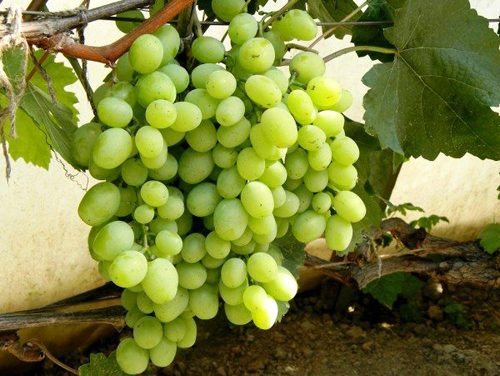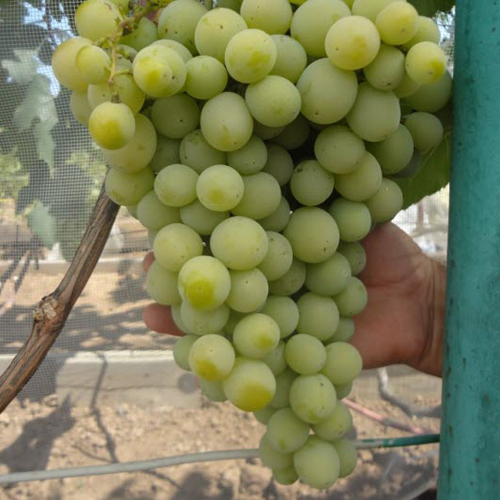Kesha grape variety
Kesha, or as it is also called, Improved Delight is a well-known table grape variety of Russian selection, obtained by crossing the Moldavian variety Frumoas Albe and, in fact, Delight. Bred by a team of scientists at VNIIViV them. ME AND. Potapenko. Of the unambiguous advantages, one can single out its early ripeness, large fruitiness, high sugar accumulation, the beauty of the bunches and, of course, the great taste of berries. For this, gourmets, connoisseurs of grapes love him, while winegrowers praise his twin brother - Keshu-1 (aka Talisman) more, which, although somewhat inferior to his brother in taste, but, at the same time, shows better winter hardiness and disease resistance.

The bushes are distinguished by high vigor of growth, quickly accumulate perennial wood and recover from frost damage. The leaf is large, dissected, three-lobed. The flowers of the variety are bisexual.
Bunches of grapes are large, conical or cylindrical-conical, moderately dense, sometimes very ornate in shape. The berry is not squeezed in them. The bunches are attached to the vine with a sufficiently long stem, which contributes to their good ventilation and facilitates harvesting. The average weight of Kesha bunches is 700-900 grams, but more weighty specimens often grow, which invariably attract the attention of buyers in the market. The berries are very large - their size reaches 32 by 25 millimeters, and their weight is 12 grams. Not prone to peas. The shape of the berries is oval, the color is white, when fully ripe, a beautiful amber-yellow hue of the bunches appears and a slight tan on the sunny side. The pulp of the variety is dense, fleshy, very sweet, with a wonderful harmonious taste. The skin is firm, but not tough, edible. There are very few small seeds in the berry - 1-2 pieces, rarely 3, they are practically invisible when eating.

The grape harvest is consumed mainly fresh, although processing into high-quality, very sweet juice is also possible. Ripe bunches can remain on the bush for a long time due to the strong attachment of the berries to the crest, without crumbling, but only improving their aesthetic and organoleptic properties. Thanks to its strong skin and dense pulp, Kesha is suitable for long-distance transportation without significant damage to the berries.
A variety of early ripening, in the southern regions it reaches ripeness already at the end of August,

As for the agrotechnical characteristics, they cannot be called outstanding. With a seemingly worthy declared frost resistance at -23 ° C, amateur winegrowers note quite serious damage caused by winter frosts. This is compensated by the high restorative capacity of the variety, however, the replacement buds are somewhat inferior in fertility to the main ones, which ultimately negatively affects the overall yield. In addition, one cannot fail to note the rather weak resistance of Kesha to powdery mildew, although increased resistance to mildew is observed in grapes. The berries on the bunch usually do not crack or rot, such damage to a certain extent only takes place after the change of extreme drought to rainy weather. Pest control should be carried out with insecticides and acaricides using standard protection schemes. Cuttings root well in the soil, but cultivation of the variety in a self-rooted culture is possible only in regions that are not infected with phylloxera.
The system of bush management in the south is standard, in more northern regions, where early ripe grapes may well ripen, it is covering.On arches and gazebos, Kesha is quite capable of growing due to the high strength of growth, however, such formations are advisable only in places where it is guaranteed not to freeze in winter. In order not to overload the bushes prone to this crop, it is necessary to cut the plant moderately, leaving no more than 40 eyes on it. The pruning length of fruiting vines of the variety should be 6-8 eyes. For planting Kesha, it is advisable to choose mainly sandy and sandy loam soils, and fertilizers, especially nitrogen fertilizers, should be used with caution so as not to provoke an excessive growth of vegetative mass to the detriment of the harvest. At the same time, in any case, it is necessary to efficiently and on time to carry out the fragment of excess shoots, pinching and lightening of the bunches, opening the access of air and sunlight to the berries in order to be able to maximize the beauty and taste of these grapes.









Kesha was imprisoned 4 years ago. The variety is unpretentious, care comes down to pruning, fertilizing and watering. But you need to pollinate, otherwise the berries will be small. There is no need to leave many brushes on one vine, it is better to cut off, then the clusters will be large and ripen in time. We all plant in irrigation ditches in the garden and in the garden, grapes are no exception. It is convenient to water, mulch, and especially cover for the winter. We put the branches of the vine in the irrigation ditch, sprinkle with oak leaves, put the boards, and on top of the covering material and straw. In the spring, we monitor the temperature, if the spring is early and warm, the grapes should be opened as soon as possible to avoid delight.
Berries are mainly consumed fresh. After harvesting, they retain their appearance and taste well for a long time.
This variety is the favorite in our family. It is declared as early ripe, but in my climate this is not so - I think that the whole point is that it blooms quite late, and then it takes a lot of time for it to grow large (very large) berries. The grapes reach full maturity in the first half of September, but the bunches hang until the first frost - the colder the nights get, the tastier and sweeter Kesha becomes. We don't take care of it in any way - I carry out a strong autumn pruning, sprinkle it with soil a little for the winter, water it 2 times per season - after flowering and in August, when the intensive growth of berries begins, we do not feed it. The variety does not suffer from diseases, wasps do not spoil the berries.